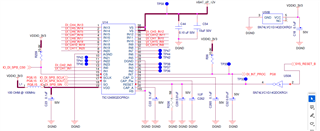Hello Team,
I have a custom board which has TIC12400-Q1 IC which can be controlled through SPI. I just new to this IC. I tried reading the data from reading the datasheet and trying to read the data from the IC but unable to read the switch status if I short the ground and input line also I can just read '0' please need some guidance in reading the data correctly.
I am able to read the device ID.
But when I try to set the mode to ADC it is not working. I am writing 0xE5FFFFFE to set the mode to ADC state. I just have a doubt can I read the state of the MODE reg. Will it return the state what I set when I was writing?
Please help me reading the states of the switch for channel 12 to channel 17.
What are all the configurations I need to follow to read the ADC status of channel 12 to channel 17?
Please help




